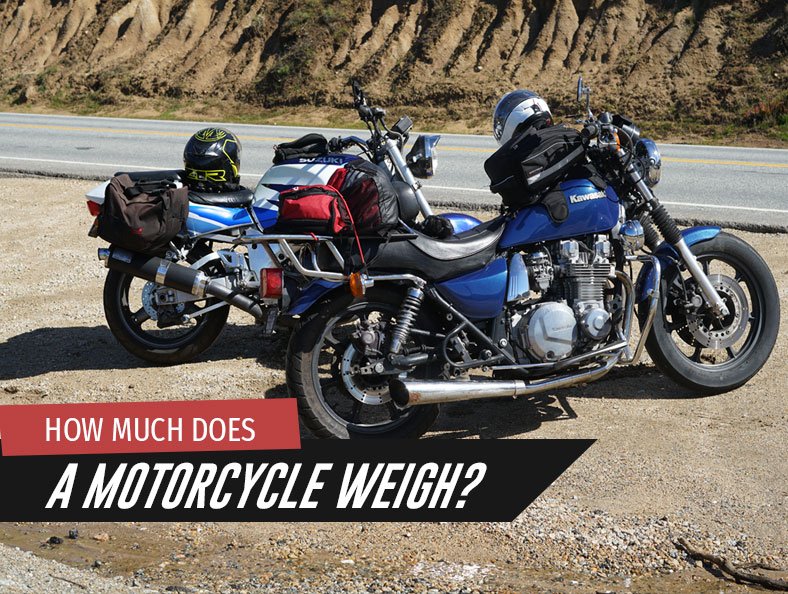How Much Does a Motorcycle Weigh? How Heavy Is It?

Do you know how much a motorcycle weighs? If you’re a passionate biker, you’re probably interested in all aspects of your vehicle but have you ever thought about how heavy it is?
Different bikes don’t look, perform or weigh the same. Still, it’s equally as important to know the exact number regardless of the motorcycle you have. For some reason, sheer mass is something most people ignore and usually don’t know to respond if asked about it.
If you’re a passionate biker, you should know about weight just as much as other details. Continue reading as we discuss ways to measure as well as why it’s important.
Ways to Measure Weight
Motorcycle mass is measured in three weights that are dry, wet, and gross vehicle rating otherwise known as GVWR.
The difference is that the GVWR is the maximum total weight while dry and wet are not standardized measurements.
Gross Vehicle Weight Rating
Otherwise known as GVWR, gross vehicle weight rating is the maximum safe mass of the bike stated by the manufacturer. This includes mass of the motorcycle itself as well as everything it carries. The information is printed on its VIN Plate.
The difference between wet and GVWR is how much a bike can safely carry the rider, the passenger, fuel, and all the cargo and accessories. The bike that has the most significant difference between the two ratings is the one that can carry the most additional pounds like extra fuel and spare parts.
This is something you should know because you and your passenger might be too heavy for the motorcycle if you’re carrying the additional load.
Dry
This is not a standardized measurement, so the number might differ from manufacturer to manufacturer. For this reason, you might find inconsistencies between the brand’s dry weight and the one published by media outlets and press due to different testing techniques.
Some manufacturers exclude gasoline only while others exclude brake fluid, coolant, and engine oil as well.
You should consider the number as an informative detail, but do remember there’s no standard way of testing dry pounds.
Some brands include batter in the dry measurement while that’s usually not included in the media outlets. Still, certain press and media outlets exclude only fuel.
Wet
Contrary to dry, wet includes but isn’t limited to engine oil, coolant, fuel, battery, and brake fluid. Still, there’s no way to standardize the testing, which is why you should treat it the same way as dry.
Council Directive 93/93/EEC in the EU specifies that wet weight is a mass in running order. This includes all the equipment such as tool kit, windscreen and about 90% of its fuel capacity fitted to your bike.
Manufacturers don’t typically publish wet measurements due to the inconsistencies found between theirs and measurements published by press and media outlets.
Different Types Have Different Averages
You can expect a variation depending on the type of motorcycle you have. You’ve probably guessed already that each type weighs differently but do you know how much each of them actually are? In the text below, we’ll state the average weight of various kinds of motorcycles.
- Moped – this is one of the lightest bikes that you can even carry up the stairs if you have some muscle. It is approximately 160 to 180 pounds which allows you to carry it anywhere.
- Scooter – scooters are between 200 to 300 pounds and is often considered to be an improved version of a moped. Still, more massive models are available, and those go up to 400 to 500 pounds. (Read more on scooters vs motorcycles.)
- Scrambler or café racer – this one is like a small tank. It usually weighs 400 to 500 pounds though some newer models are even more than that. In most cases, it depends on add-ons.
- Cruiser – cruisers can range the most as some have 400 to 500 pounds while others go up to 700 pounds.
- Bagger – bagger bikes range from 700 to 850 pounds on average. It’s still one of the heaviest bikes available, and it even has some rear storage that usually means additional pounds.
- Sport bike – these are considered as mid-range bikes since they weigh from 300 to 500 pounds. In most cases, they have little storage through the weight usually depends on the size of the engine.
- Touring – touring motorcycles range from 800 to 1000 pounds in most cases. These are among the heaviest bikes you can buy.
- Dirt bikes – these are among the lightest motorcycles you can buy. Since they range in size, they also vary in pounds, so you’ll find anything from 100 to 250 pounds on average. Learn how to ride a dirt bike.
- Adventure bike – these are similar to dirt bikes, though they weigh more at approximately 500 to 650 pounds. If it has storage, it might weigh more.
- Chopper – choppers like Harley-Davidsons weigh from 650 to 720 pounds and are among the heaviest bikes available.
Why There Are So Different
It varies depending on the components your bike is using. Things like engine, exhaust system, wheels, fastener, braking system, battery, and others are all affecting the overall pounds on your bike.
The engine is usually the one that adds the most to a motorcycle. In most cases, they affect the overall stability and speed.
Plus, motorcycles are designed in a way to work the best for what the purpose. So, a dirt bike has to be lightweight, or it won’t be suitable for that type of riding style. A heavy dirt bike wouldn’t work so well.
Those that are lightweight are usually easier to handle. They’re simpler to maneuver with since you don’t have to handle as much as you do with a heavier bike.
Still, you shouldn’t fear heavy bikes since you can do a few mechanical tricks to reduce the numbers a little.

Why Weight is Important?
Different bikes are suitable for a different style of riding. Since all these styles differ in many ways, the bikes also must have crucial differences.
Imagine a lightweight bagger bike or a heavy dirt bike. Those wouldn’t work well for the type of riding they’re meant for if the weight wasn’t just perfect. This directly affects stability, ease of handling and balance of the vehicle.
How to Decrease It
- The easiest way to do this is to replace your wheels with lighter ones. They tend to add a lot to the vehicle, so opting for lighter ones would reduce that number.
- Another thing you can do is shorten the seat. It’s a small change, but it does make a difference, and it’s also easy to do.
- If you have a toolbox container attached to the vehicle, you might want to consider removing the toolbox. Still, think about if the tools are necessary on your every ride, and if not, choose to ride without the box in order to reduce the numbers.
- When you replace the wheels, you can also replace the rims. Rims add a lot of deadweight especially the original manufacturer’s models.
- Exhaust system tends to add unnecessary pounds. You can replace them easily, especially since so many lightweight models are available. They’re equally as well-made and durable, but they weigh significantly less.
- Fenders might also be an issue so shorten or replace the front and rear ones for a more lightweight option.
Conclusion
Weight is among the most critical aspects of your motorcycle. It’s among the details that determine how the bike performs for the particular riding style and road surface. Too much or too little of it might be an issue at times, so make sure to consider this carefully.
Now that you know how it’s measured and why it’s essential, you can also consider reducing some of it in a few different ways. Still, remember that safety should always come first, so make sure to have a professional help you with this.






